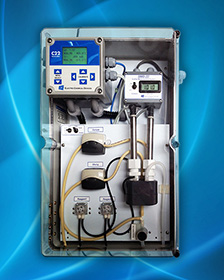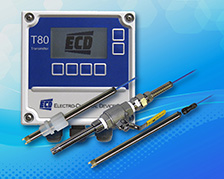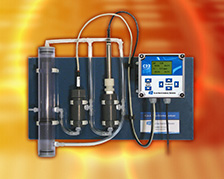Versatile Fluoride Monitoring Solution For Semiconductor Fabrication Wastewater Treatment
Dual-Channel Transmitter Monitors Both Fluoride and pH for Reliable Accuracy
Electronics manufacturing engineers and plant technicians in need of a Fluoride measurement solution will find the new Fluoride Monitoring System from Electro-Chemical Devices (ECD) provides a highly accurate turn-key analyzer solution for semiconductor wastewater treatment processes.
The next-generation Fluoride Monitoring System from ECD is designed with its new advanced dual-channel T80 Universal Transmitter and precision S80 Intelligent pION Sensor for Fluoride and S80 Intelligent pH Sensor. Together, they provide highly accurate and reliable measurement of Fluoride for electronics industry manufacturing plant wastewater treatment.
The T80 Transmitter provides dual-channel comparison of measurements or inputs, which can improve the accuracy of Fluoride measurement. For example, Fluoride ions are affected by changes in the pH of a solution. The correct measurement of Fluoride levels is only possible if pH is also measured and appropriate compensation algorithms are processed. The S80 pH Sensor and the dual-channel T80 Transmitter easily handles these types of measurement comparisons.
The efficient use of Fluoride is an important part of the semiconductor industry’s fabrication process. Effective etching of semiconductor wafers is dependent on Fluoride usage. Such processes produce wastewater and effluent contaminated with Fluoride, which must be accurately analyzed for effective treatment.
ECD’s S80 pION Sensor for Fluoride combined with the T80 Transmitter are well suited for this task. ECD’s S80 pION Sensor for Fluoride’s specific (pIon) electrode cartridge measures the activity of “free” Fluoride ions in solution in concentrations from 0.02 to 2,000 ppm over a pH range from 5-8 pH. They operate over a wide temperature range of 0 to 80º C. The S80 Immersion or Insertion Sensor is designed with a 0.75-inch MNPT compression fitting as the process connection and allows a variable insertion length to accommodate installation in pipe tees, flow cells or through tank walls. The S80 Retractable Sensor is designed with a 1-inch MNPT ball valve, a 1-x-0.75 inch reducer and a 0.75 inch MNPT compression fitting to provide the process connection.
In addition to Fluoride measurement, ECD’s replaceable electrode cartridges for the S80 pION Sensor for Fluoride can also be selected to measure parameters including other specific ions, pH, ORP, dissolved oxygen, conductivity and resistivity. These cartridges provide specific industrial process measurement solutions, and they are constructed in a variety of configurations and materials to support diverse industries.















